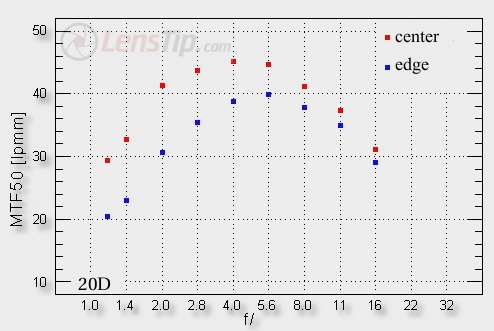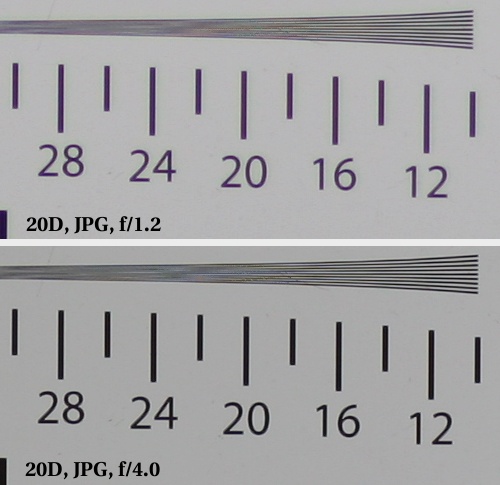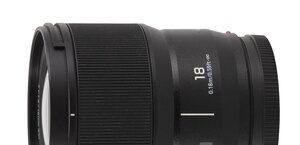Canon EF 85 mm f/1.2L II USM
4. Image resolution

We were very curious about the maximum aperture results. When wide open, most of the fast 50-85 mm lenses have some problems to exceed the 30 lpmm value, considered by us to be the lowest possible good quality level. To be honest, our charts proves that the 85L is a lens of the highest class indeed. By f/1.2 we find ourselves indeed in the vicinity of 30 lpmm, so the images will be useful for sure. By f/1.4 we already reach above 32 lpmm, but in the f/2.0-f/4.0 range we are breaking resolution records. By f/4.0 the Canon EF 85L had the result of 44.9 lpmm so officially the highest value recorded in our tests on a 8-megapixel 20D sensor. It puts the lens in a very good light – at least in this case we know what we have paid for.
Please Support UsIf you enjoy our reviews and articles, and you want us to continue our work please, support our website by donating through PayPal. The funds are going to be used for paying our editorial team, renting servers, and equipping our testing studio; only that way we will be able to continue providing you interesting content for free. |
- - - - - - - - - - - - - - - - - - - - - - - - - - - - - - - - - - - - - - - - - - - - - - - -
If the APS-C sensor corner is concerned, we don’t get the required resolution at the maximum aperture. Only on stopping down to f/2.0 the pictures become better and, after further closing, the results are just brilliant. It’s enough to say that, by f/5.6, the lens reaches almost 40 lpmm so the level, many other lenses have serious problems to get even in their frame center. We can remind here the result of an L-class 24-70 mm model, f/2.8, at 70 mm focal length. By f/5.6 in the frame center it had the result of 39.6 lpmm so, taking into account the margin of error, as much as the 85L on the edge…
Now let’s proceed to the full frame performance. There is a real comfort in testing lenses on 20D and 1Ds MkIII cameras as their pixels density is the same. In theory, they should give exactly the same MTF values but in practice, the much newer 1 Ds’s sensor fares better, often having, at the same aperture, the results by 1-2 lpmm higher. The difference is small, though, often within the margin of error, so the results from both bodies can be: firstly, compared directly between themselves, secondly, mutually controlled when it comes to potential errors. Let’s look at the MTF50 values chart, obtained with the help of the EOS 1Ds MkIII camera.

In the frame center there’s no surprise waiting for us – we find out the same as from the 20D test. The function graph is almost identical, and the values at particular apertures differ from those, reached on the 20D by 1.1 lpmm at most. The conclusions are also the same – it’s a sensationally sharp lens, already useful from the maximum aperture.
When it comes to the frame edge, though, we have less reasons to go into raptures. A full frame, densely packed with pixels, is very demanding and lenses have problems to face up to these demands, especially near maximum aperture, where the MTF values don’t reach even 20 lpmm. Only on stopping down to the proximity of f/2.8-4.0 we will get a sharp image even in the frame corners.
Currently, we don’t have the full frame tests’ range wide enough to be able to assess the 85L performance on the frame edge in an unequivocal way. Fortunately, not so long ago a Samyang 1.4/85 fell into our hands and we tested it on a full frame D3x. The Nikon body, although with more pixels than 1Ds MkIII, generates very similar MTF values so once again, the comparison is possible. The 85L was the winner of that comparison by the way, because the Samyang only near the aperture range of f/8-11 approached the vicinity of 30 lpmm. What’s interesting, at the maximum aperture both lenses fared alike although, in the case of the Canon, the price is as much as ten times higher!
 |
At the end one more digression but an important one and interesting as well. The Canon 85L, for the reason of its brilliant sharpness, can be used to prove the lack of sense when it comes to testing optics on sharpened files (especially JPEG files) and on sensors with too low pixels density as well.
Not so long ago, a well-known and widely printed magazine published an 85L test, conducted on a Canon EOS 5D camera. They did what our editorial team had refrained from doing for a long time, arguing that a 12 megapixels full frame is not the right instrument to test lenses as its sensor hardly demands enough. That magazine’s editorial team, though, decided to test the lens in that way and even used sharpened files for that purpose. As a result, we got a paean to 85L, because the results in the frame center were, in the margin of error, almost the same as on the frame edge. An ideal lens! Unfortunately, if somebody from that team was more insightful about the result, they would reach a conclusion that something must have gone wrong. As we will be able to find out in a moment, the 85L has a significant coma and in the full frame corners its vignetting level is 2 EV. Its chromatic aberration is also at a non-zero level. The presence of off-axis aberrations suggests unanimously that the full frame edge resolution of this lens cannot be the same as in the frame center. Of course it isn’t the same, as it is shown by our test, based on non-sharpened RAW files from the EOS 1Ds MkIII.
Sharpening is the next issue. We have emphasized several times that the optics tests based on sharpened files are simply reprehensible. Regrettably, most of portals and magazines test lenses in such a way. As a result, we get strange charts, in which a lens at almost all apertures reaches the resolution level above the Nyquist frequency threshold (so the maximum theoretical resolution of the camera body, used for testing.), bad lenses turn into good lenses and there is no possibility to compare results between particular systems. Let’s show how sharpening can doctor the results. In order to do that we should return to the first chart from this chapter, which shows MTF values measured on the strength of the RAW files from the Canon 20D. Now, let’s draw a frame centre resolution chart for the 85L and 20D set, mentioned before, but not based on the RAW files, as it was done at the beginning, but based on the JPEG files, saved along with them. The sharpening was at the tolerably moderate 0 level (Parameters 2 style of image). The result is presented below.

Here we have a story known from other portals. The results reach the level of 66 lpmm, so 2000 LWPH – these values are completely non-physical, taking into account the fact, that the 20D sensor is only 2336 pixels high. What’s more, we observe a complete flattening of the most interesting range. Please notice, that the values in the f/2.0 to f/8.0 apertures range are exactly the same within the margin of error. That’s not the end, though. Sharpening is non-linear, helping weak pictures more significantly than the good ones. The graph, based on sharpened files, will be showing fantastic maximum aperture results, only a bit over 10% worse than the best possible achievements. In reality, the difference amounts to 50%, what the RAW test showed very clearly. This little experiment demonstrates how trustworthy are tests, based on sharpened and/or JPEG files.






